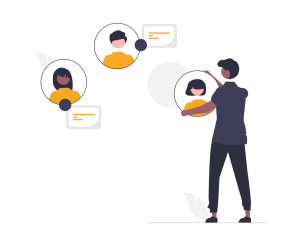
Coding Connections: Blended Learning in Enterprise Application Development
- ComputerScienceEducation
- SoftwareDevelopment
- PeerLearning
In this case study, the instructor applies blended learning techniques to an advanced software development course to give students an authentic experience of software development closely mirroring the experience of developers in industry. An online discussion forum significantly increased engagement and peer learning while allowing students who otherwise find it difficult to ask questions in front of a class to make themselves heard.
Context
This case study describes a blended learning transformation that took place at Technological University Dublin (TU Dublin) in 2023. Blended learning refers to teaching methods that combine both online and in-person classes. TU Dublin defines blended learning as a delivery mode comprising at least 30% online sessions and 30% face-to-face sessions.
The instructor decided to incorporate blended learning techniques into the delivery of Enterprise Applications Development (EAD), a module offered to 4th-year undergraduate computer science students. EAD is an optional course that teaches students to build advanced applications using web technologies.
The purpose of the EAD module is to study and implement advanced tools, technologies, and libraries using JavaScript to develop web applications, covering the whole application pipeline from back-end to front-end and database connections, including user session management.
Dr. Luis Miralles recognized that the software development field is rapidly evolving, and practitioners need to stay up-to-date with the latest technologies. This course aimed to empower students to become proficient in new technologies independently, preparing them for their careers. Additionally, the instructor sought to increase overall student engagement by addressing social barriers to participation in face-to-face classes.
People Involved
The module was delivered to 80 full-time undergraduate students. Lectures were delivered to the group as a whole in weekly two-hour sessions with practical lab work. Students were split into three groups, each led by the instructor or a laboratory assistant. Lecture materials and recordings were available on Brightspace, the university’s Virtual Learning Environment (VLE).
Dr. Luis Miralles had no prior experience with blended learning but had learned about these techniques through a qualification in University Teaching and Learning the previous year. The students were in their early twenties, completing their undergraduate program. Students chose this module because of its practicality, hands-on experience, and use of cutting-edge technologies.
Before the transformation
Before the transformation, the course was exclusively delivered in person. Students worked on their assignments in their own time, and towards the end of the semester, they were required to demonstrate their projects during class time. The instructor spent a significant amount of time explaining concepts, answering emails about course tools, and troubleshooting programming problems, leaving less time for independent exploration.
Students were often hesitant to ask questions or engage in peer learning in a physical classroom, a common challenge among undergraduate computer science students. The lecture was scheduled in the late afternoon, making it difficult for some students to attend due to other commitments or final-year projects.
The transformation
The instructor adopted a HyFlex model, delivering lectures in person while live-streaming and recording for online students. Recordings were available for students to revisit. A quiz-based platform, Kahoot, was used for periodic topic assessments. The instructor also created an online discussion forum, encouraging students to ask questions and rewarding quality contributions.
The instructor also created an online quiz based on Kahoot [3] at the beginning of many topics which was used by the students and the instructor to measure their understanding of the previous topics. Kahoot is an online platform to create quizzes, the app creates rankings, has music, and creates statistics. You can give 10 seconds to answer but if you have a student with dyslexia or a student with visual impediment, who may need a person to translate, you may need to give 20 seconds. The game gives four options and gives more points if users answer quickly. The free version has a limit of 50 users, but this is generally enough. Students tend to like quizzes. The game has an initial screen with a code used by the students to connect to the platform. The students can use whatever name they want, usually a funny one, so they are not recognized by the lecturer in case they perform badly which takes away pressure from them.
The instructor set up an online discussion using the VLE. Students were encouraged to ask questions in the forum and to answer other questions if they could. Class forums can sometimes be difficult to run as forums need to hit a critical mass of activity before students think to use them when they encounter an issue or solve a particularly tricky problem which may be of interest to their classmates. With this in mind, the instructor motivated the students to contribute by making it a requirement of the assignment that the students create and reply to at least one topic. This proved very successful, and many students posted and replied to multiple topics even though it was not required for their assessment.
The assignment required students to submit a video demonstration of the application they built for their end-of-semester assessment. Students were previously required to write up a document describing the project including screenshots of the application in action. Students appreciated this change and the quality of submissions was quite high. Instructors found that this saved time, as they no longer needed to run the students’ code on their own machines. Running code submitted by students can by a time-consuming process as considerable work is required to install the necessary packages. As there were 80 students in the class, videos were required to be no more than two minutes long. This helped to make the workload in terms of corrections more manageable for instructors. The forum was also used by the lecture to answer questions to the students that otherwise would have been asked multiple times by email.
The instructor revised the module content to give students more freedom to work independently and explore options not directly covered in the module content. This meant that the instructor spent less time standing in front of the class talking and the students took more responsibility for their own learning. The experience was heavily scaffolded for students, however, to ensure that they had ample resources and directions on how to find the information they needed. Overall, this resulted in a large initial time investment in terms of lesson preparation.
After the transformation
Feedback from students was generally positive. They particularly enjoyed the online forum which, with a small amount of curation on the part of the instructor, has become a valuable collaboratively built resource. Students reported finding it easier to ask questions on the forum than in class. This may be in part due to the fact that, as computer science students, they are well used to posting in questions and answers forums; and appreciate the fact that the spotlight is not on them when they ask a question. The forum fostered a lively peer-learning atmosphere, which has been shown to have great benefits for students regardless of whether they are learning from or teaching each other [1]. This will definitely be repeated in future years. Part of the success of the forum discussions was the fact that students got some marks for their comments. Otherwise, as it has been reported in the literature [5], the general students’ participation would have been low. The students also enjoyed the kahoot quizzes although doing them in every class can be a bit boring, so it is best to do it every two or three sessions.
The extent to which the recorded lectures were utilised by students is unclear. In future years, care will be taken to deliver the material to students in such a way as to allow the instructor to monitor usage statistics. Making recordings available to students can be highly beneficial in allowing students additional flexibility in structuring their personal timetables. Anecdotal evidence, however, suggests that there is a possibility that when recordings are available students tend to put off watching them, knowing that they can do so at a later date. Often this is left too late, and students do not find the time to catch up during the semester. Live-streaming deliveries without making recordings available offers some of the flexibility to students while still requiring them to make the time to watch them. With increased monitoring in future years, a decision will be made on whether or not to switch to a streaming only HyFlex delivery.
The instructor also tried to apply discussion groups in class in person, but students did not seem to be very happy to interact in public. Maybe this is because computer scientist tends to be a bit more introvert or maybe because the covid-19 pandemic still influences them. In this case, the instructor decided to create five different groups and students had to argue whether it was better for a company to create a website or if it was better to create an android application for their product. The groups that were in site found it easier to argue but the ones which were online did not want to engage so much and it required a lot of effort form the instructor to keep them engaged. However, the next time a discussion group was planned there where less students in site and more online and engagement was quite difficult. So, the instructor decided not to run more discussions.
Physical attendance at the HyFlex classes was lower than in previous year. Student attainment showed that engagement remained as high or higher than before, but the instructor feels that the remote option decreased the level of face-to-face interaction in the class. Part of the beauty of university life is the personal connections made. Making friends and building networks for the future is an essential part of the experience. Online education has a few important drawbacks [6], students find it harder to connect with other students, this is especially true when they are not able to see then even in camera, and also, they get more easily distracted by the disruptive notifications in the shape or emails or messages that they get during the class.
It was observed that the blended approach may have adversely affected this aspect of university life. Engaging with both online and in line students can be a bit challenging as the lecturer will naturally focus on the students that are in class. It is also hard to be always on camera as the lecturer likes to move around the class not being static. It is hard to see the screen with the camera as the resolution from a distance is not very good. And writing on the slides can be difficult or slow to do.
Technologies Employed
HyFlex lectures were recorded using a computer and webcam in the classroom. One issue commonly faced by lecturers delivering HyFlex classes is that they need to stand in front of the microphone for the entire delivery. This can lead to audio issues for students attending remotely which is often not brought to the instructor’s attention at the time. The instructor used a small lapel microphone which connected to their phone and allowed them to move around the classroom, leading to a more natural delivery. These are widely available, relatively cheap and a worthwhile investment for lecturers delivering in the HyFlex modality. Quizzes were implemented using the Kahoot platform. And the students were also able to answer questions using the polling methods of university’s VLE.
Videos were recorded and made available to students through the virtual classroom tool as part of the university’s VLE. This had the advantage of being familiar to students and the instructor, but did not allow the instructor to track usage. In future years a different platform will be used allowing the instructor to track student views and evaluate the usefulness of this aspect of the delivery more thoroughly.
The discussion was forum was created using the university’s VLE. This worked very well. Making participation in the forum a requirement of an assessed assignment was crucial to the success of this aspect of the delivery. This approach allowed the forum to hit a critical mass at which point many students opted to continue using it even without the extrinsic motivator of marks. This will definitely be repeated in future years.
Reflections
Challenges Faced

The video demonstration of the assignment worked well but it was observed that physical attendance was significantly lower than in previous years. This had a knock-on effect on the overall atmosphere in the classroom, particularly towards the end of the semester when students were busy finishing their final year projects. In future years, students will be required to present their demonstration in person to ensure that they retain some physical connection with their classmates and not miss out on important holistic aspects of university life.
In site group discussion was not as successful as expected since many students did not want to engage or were reluctant to give their opinion. Additionally, Kahoot quizzes seemed ot be a bit for younger years and doing too many of them can be counterproductive. However, doing three or four quizzes can be a good idea to get a feel of the level of understanding of the class and give them some feedback.
The discussion forum was very successful; students enjoyed the experience, engaged in peer learning and demonstrated deep and authentic learning.
The focus on independent learning was well received by students and the quality of end-of-semester projects was higher this year than in previous years. This gives student an authentic experience of the workplace, and teaches them the fundamental tools required of any software developer; the ability to constantly re-educate themselves as technology moves forward.
What went well?


Was it worth it?
Overall, the instructor felt that this transformation was successful. Students enjoyed the new approach to learning and the quality of the end-of-semester projects was quite high. In encouraging the students to work independently, the instructor found themselves preparing content in order to provide students with the requisite scaffolding needed to succeed. On the other hand, they spent less time acting as a sage on the stage, standing in front of the class talking, which allowed them to engage more directly with students. Two main lessons were taken from this experience. Firstly, when blending, it is important to give consideration to the impact it may have on more holistic elements of student life, such as the time spent with friends and meeting new people. In future years there will be an emphasis on requiring all students to be present occasionally in order to preserve the atmosphere of university life and to prevent students feeling isolated through remote-only attendance. Secondly, it is important to track usage of recorded videos. The platform used gave no viewing statistics so the instructor was unable to determine whether this approach resulted in a net positive experience for students. Overall, however, the blended approach gave students an authentic experience of software development, closely mirroring industry practice. Students responded very positively to this and many students used the additional freedom to deliver projects of significantly higher-than-expected quality.
[1] Boud, David, and Ruth Cohen. Peer learning in higher education: Learning from and with each other. Routledge, 2014.
[2] Ochoa, Gabriela, et al. “HyFlex: A benchmark framework for cross-domain heuristic search.” Evolutionary Computation in Combinatorial Optimization: 12th European Conference, EvoCOP 2012, Málaga, Spain, April 11-13, 2012. Proceedings 12. Springer Berlin Heidelberg, 2012.
[3] Toma, Florentina, Daniel Constantin Diaconu, and Cristina Maria Popescu. “The use of the kahoot! learning platform as a type of formative assessment in the context of pre-university education during the covid-19 pandemic period.” Education Sciences 11.10 (2021): 649.
[4] Graham, Charles R. “Blended learning systems.” The handbook of blended learning: Global perspectives, local designs 1 (2006): 3-21.
[5] Adnan, Muge, Filiz Kalelioglu, and Yasemin Gulbahar. “Assessment of a multinational online faculty development program on online teaching: Reflections of candidate e-tutors.” Turkish Online Journal of Distance Education 18.1 (2017): 22-38.
[6] Selwyn, Neil. “Digital downsides: Exploring university students’ negative engagements with digital technology.” Teaching in Higher Education 21.8 (2016): 1006-1021.
